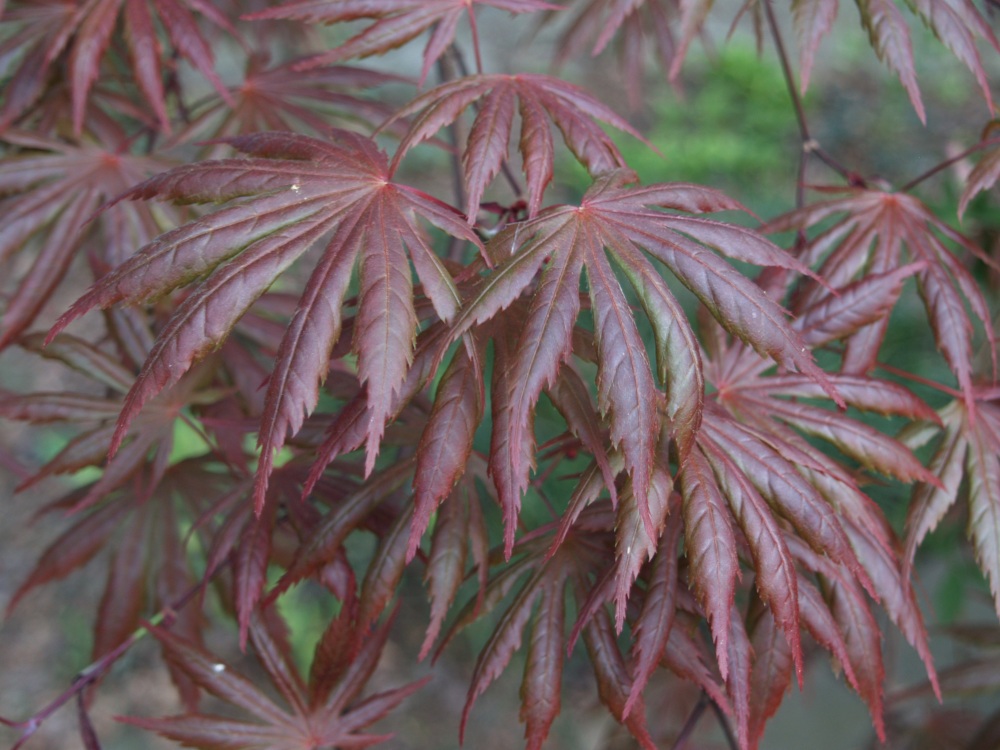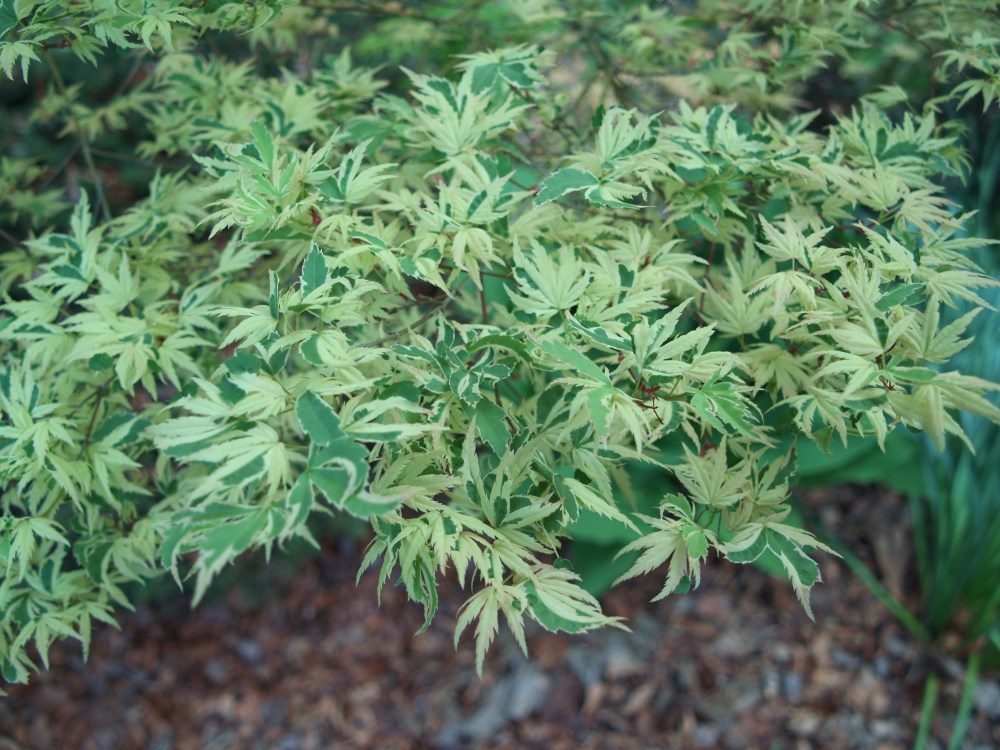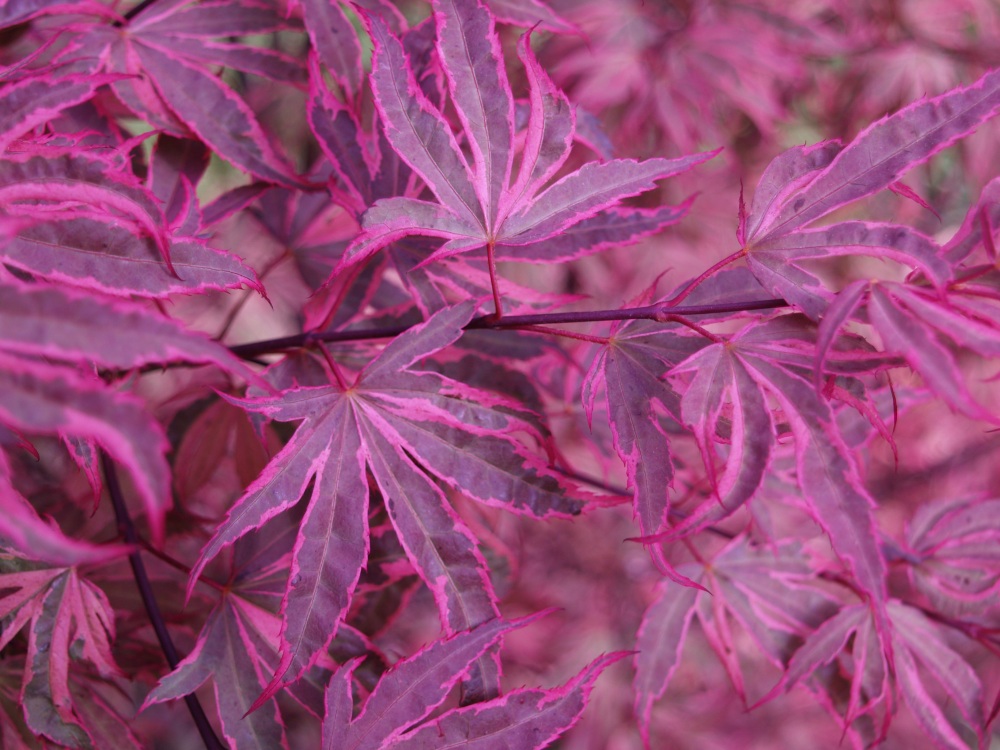The Golden Full Moon maple (Acer shirasawanum ‘Aureum’, below) leafs several weeks after the garden’s other Japanese maples. It’s in nearly full sun, which is not it’s preferred location since the yellow foliage is prone to sunburning (though this has not been a problem for me). But, this should speed leafing in the spring, not delay it. I suppose that it’s the nature of the beast, and it’s not a problem, but it creates a bit of concern when other maples are full and lush and there’s barely a bud showing on the Golden Full Moon maple. Even when it begins to break into leaf, there’s a leaf here and there, and it takes a few weeks for it to fill out. Today, it’s about three quarters full, but it’s progressing nicely.
This is a tree that I lusted after for years, and was even tempted to purchase a small sapling through mail order since I could not find a larger one. The Full Moon maple is slow, and I’m an impatient gardener, so fortunately I stumbled over a tree in a Japanese maple grower’s field in Aurora, Oregon that had been left behind due to damage to its trunk. The injury proved to be superficial, and I’m overjoyed to include this treasure in my little collection of Japanese maples.
Most of the maples in the garden are not unique or rare, and several are downright common, but rare or commonplace matters little to me. A few of the Japanese maples have been here for more than twenty years, and others only for a year or two (and one for only a few months). As the garden has filled to capacity in recent years my selections have turned to ones that stay relatively small, and I’m always anxious to add another.
A simple fact is that red leafed types will be most popular in garden centers, and that red leafed varieties with pendulous branching will be most requested. I’ve planted red leafed upright and weeping varieties, but also ones with green, yellow, and variegated foliage. I don’t think that there are any foliage types that I don’t have at least one of, though my collection of twenty three varieties is only a small fraction of the twenty five thousand named varieties.
The most recent Japanese maple I planted was the green and white variegated ‘Butterfly’ (Acer palmatum ‘Butterfly’, above). There is another on the shaded south side of the house, and while most maples perform best in full sun, ‘Butterfly’ has done quite well with little sunlight. I planted the new maple at tip of a curved point in the large koi pond (which was previously referred to as the swimming pond, but my wife informs me that I should not swim/float in it any longer with so many fish). A Japanese maple that was planted a year ago was removed, which was a shame since I planted it believing it was the variegated ‘Floating Cloud’ maple (Acer palmatum ‘Ukigumo’, below). As it turned out, the tree was mislabeled, leafing out a sad looking green and proving to be the single most unremarkable Japanese maple I’d ever seen.
This was a horrible disappointment since I have seen too many ‘Ukigumo’ maples going to waste with the vast oversupply of Japanese maples the past several years in Oregon, and it seemed such a simple thing to have one of my own. Alas, it was not meant to be, and I’ve moved on, though if the opportunity to get a genuine ‘Floating Cloud’ comes around I’ll certainly find a spot for it. In any case, the green leafed maple was dug out and ‘Butterfly’ was planted in its place, where it is a slightly better choice since it is a bit more tolerant of one of the few full sun spaces remaining in the garden.
Late spring is the prime season for Japanese maples in the warm and humid mid Atlantic region (or upper south, whichever you prefer). By mid summer many maples in full sun begin to show a bit of stress, and some red leafed varieties begin to fade. They are still healthy, but the maples are much happier in cooler temperatures, and in May and June their foliage color is most vivid.
In May the foliage of ‘Gwen’s Rose Delight’ (Acer palmatum ‘Gwen’s Rose Delight’, trade name ‘Shirazz’, above) is purple with a pronounced pink edge, a striking combination that attracts the immediate attention of visitors. Unfortunately, by August the foliage has faded to a bedraggled red-green, and the pink edge is only a memory, but for a few months in the spring there is no Japanese maple so delightful. For this reason, ‘Gwen’s Rose Delight’ should probably not be the only maple in your garden, but in this garden it is one of many, so I can simply avert my gaze when it’s not at its prime.
I love Japanese Maples, have you seen the large selection over at Susanna Farm Nursery in Boyds, MD? http://www.susannafarmnursery.com/ The ‘Gwen’s Rose Delight’ is gorgeous!
I haven’t visited Susanna Farms, but I’ve seen their plants at local garden shows. They do a nice job.
I just read your post, and I noticed you had some trouble with your Ukigumo. As I read on is sounds like you had it planted in a rather sunny location. Don’t give up on this cultivar (unless you live in the south). Ukigumo shows best in total shade. If it gets too much sun (even 1 hour of midday) it will leaf out all green. Keep it in dense shade at all times and you will be rewarded with plumes of white. Oddly, it also requires a little cold to get the white colors. I let it leaf out indoors as an experiment and it was green.